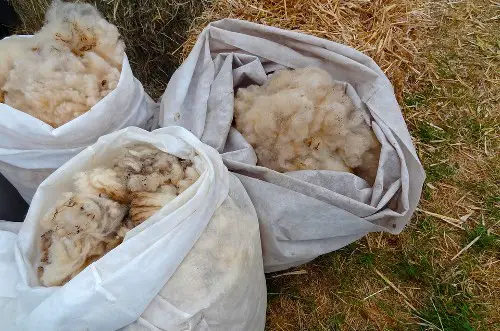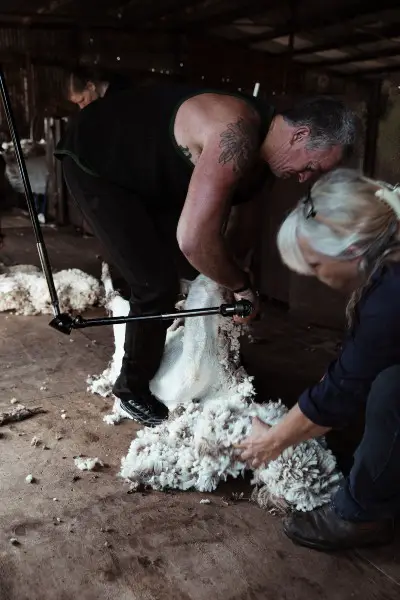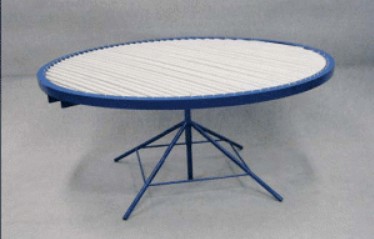Have you ever wondered about what skirting wool is? Or maybe you’re new to skirting wool fleece, don’t worry – it’s not as difficult as it might first seem. This guide will provide you with an in-depth look at how to skirt a raw wool fleece. We’ll walk you through the skirting process step-by-step so that you can get started.

What Does Skirting Wool Fleece Mean?
If you’ve ever sheared a sheep or when you first got your hands on a freshly shorn fleece, then you know that it’s full of all sorts of debris – hay, grass, straw, leaves, twigs and second cuts.
The process of removing all sorts of “waste” from the sheep’s wool is called skirting. Skirting wool is usually the next step after shearing has been completed.
Why Do You Need to Skirt Your Fleece?
Skirting wool is an important part of the process of preparing sheep’s wool for spinning, felting, or any other use.
Debris removal is essential before you begin spinning wool into yarn or attempting to sell the wool.
By removing the wool waste from your fleece, you’ll end up with a cleaner and higher-quality product. In addition, skirting wool can help to:
- remove any unwanted materials that could be difficult or impossible to remove later on
- make the fleece easier to work with
- catch the eye of the potential buyer
- increase the overall value of the fleece
Once the wool has been fully skirted, it’s ready to be used!
When Should You Skirt Your Fleece?
The best time to skirt your fleece is right after shearing. This is because the wool will still be fresh and it will be easier to remove all of the debris.

If you can’t skirt your wool fleece right away, it’s still important to do it as soon as possible. The longer you wait, the harder it will be to remove all of the waste.
Preparation for Skirting Wool
Before you start skirting, you must select the appropriate skirting table. A wool skirting table or even a normal large table can work well for this.
If you have a normal table, lay the fleece out on the surface and then go through it by hand, picking out all of the debris while going around the table. Just keep in mind that, this can be a time-consuming process, especially if you have a large amount of wool to skirt.
Another way to skirt wool is to use a special table called a “wool skirting table”, which is specifically designed for this purpose. These skirting tables have an open mesh top (usually with round tubes) that helps the debris to fall on the floor as the fleece moves along the table.
This is a faster method.
If you have the opportunity, we highly recommend investing in a round wool skirting table with a 360-degree rotation, so you don’t have to move around the skirting table to access the fleece.
The Wool Skirting Process Step By Step
Now that you know the basics of what is skirting wool and why it’s important, it’s time to learn how to do it!
Here is a step-by-step guide on how to skirt a wool fleece by hand:
Step 1 – Start by laying out your fleece on a wool skirting table (or another flat surface if you prefer). Make sure that the fleece is spread out as evenly as possible.
Step 2 – Once the fleece is laid out, choose a starting point and begin picking through it by hand.
Pay close attention to the edges of the fleece, as this is where most of the waste will be.
Remove all the stained wool at the tail. Remove all hair fibers on the upper legs if you see any.
Step 3 – Pick out any pieces of vegetable matter like hay, grass burrs, or straw.
It’s important to be very gentle so that you don’t damage the wool.
Once you’ve removed all the pieces of vegetable matter, you’re ready to move on to the next step in skirting fleece!
You should be careful not to rip the fleece when skirting it. The fleece has come off the sheep in one piece and should remain that way throughout the process of skirting.
Step 4 – The next step of the wool skirting process is turning the wool fleece over and checking for second cuts. Second cuts happen when the same part of the fleece has been sheared twice, and only a small amount of wool is left over. These leftovers are not used during hand spinning.
Second cuts happen because the person shearing the sheep missed a spot the first time around. This can happen for a variety of reasons, but it usually happens because the person shearing is working too quickly and not paying close enough attention to what they’re doing.
Step 5 – Flip it over several times to ensure you’re not missing anything.
Step 6 – Roll up the wool and put it into a plastic bag or another container to keep it clean and protected.
There you have it! You’ve just successfully skirted your wool fleece. Let’s take a look at some of the most common issues you might encounter while skirting wool fleece and how to avoid them.

Common Skirting Wool Issues (and How to Avoid Them)
Even if you’re being careful, there are still some common issues that can occur while skirting wool fleece. Here are some of the most common problems and how to avoid them:
Damaged Wool
One of the most common issues people have when skirting wool is that they end up with damaged wool. This happens because people are too aggressive when picking out the debris, and they end up cutting or breaking the fleece in the process.
To avoid this, it’s important to be gentle when skirting wool and to take your time.
Canary Stain
If you’re in the business of selling sheep wool, then you’re probably all too familiar with canary stains. For those who don’t know, canary stains are large, yellowish-brown patches that indicate a parasitic infection in the sheep. which is why a fleece with it may smell a bit yeasty
This is the reason why a fleece containing one may have a yeasty odor.
Not only do they make the wool much less valuable, but they also make it more difficult to sell.
The best way to prevent canary stains is to keep your sheep healthy and free from parasites. This can be done by using preventive treatments and regularly inspecting your flock for signs of infection. If you do find an infected sheep, it’s important to isolate it from the rest of the flock and treat it immediately.
Breaks
Breaks are another common issue with wool fleece, they are weak spots in the fleece where the wool has been damaged. This can happen for a variety of reasons, but it is usually due to inappropriate sharing techniques. Breaks make it more difficult to spin the wool and can cause the finished product to be weaker.
The best way to avoid these issues is to choose a reputable shepherd who uses proper shearing techniques. You should also skirt your wool as soon as possible after receiving it to remove any debris that could cause breaks.
What’s next?
Now that you know how to skirt wool, you’re ready to move on to the next step in the wool processing journey – taking pictures!
Take Photos of the Skirted Wool and Market It to Customers
Take pictures from the inside and outside of the skirted wool fleece and pictures of the crimps. A good photo can tell a potential buyer everything they need to know about your fleece. A single photo can answer all of these questions and more.
Selling wool on Facebook or other social media is a great way to reach a larger audience and sell more of your product. You can find many Facebook groups where people are looking for raw skirted wool to buy so they can make their own yarn.
By joining these groups you can be sure that you are reaching your target market. So take advantage of social media and start selling today!
Also read: Worsted Weight Yarn
Skirting Wool – Have Fun With It! (Conclusion)
If you’ve recently completed the wool skirting process, congratulations! You’ve taken an important step in ensuring the quality of your fleece.
It’s important to skirt wool fleece because otherwise, you’ll end up with a lot of unusable wool. By removing the parts of the fleece that can’t be used, you’re left with high-quality wool that can be used for hand spinning.
If you’re new to wool skirting, don’t worry. It’s a relatively simple process that just takes a little bit of time and patience. With a little practice, you’ll be an expert in no time!




Pingback: Worsted Weight Yarn - All You Need to Know About - ChickenMag